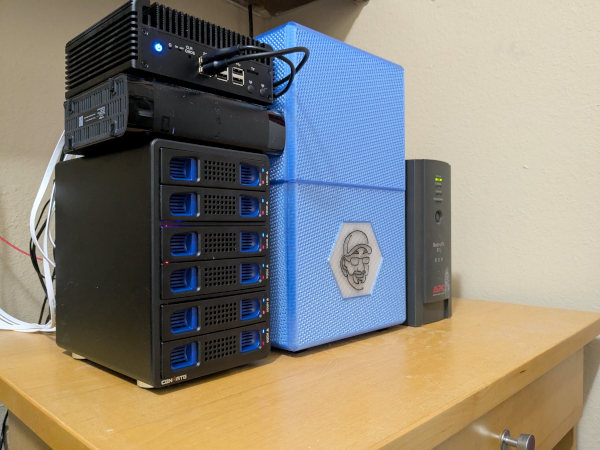This seems like a question that could be easily answered with math, but there is a big problem. This question has a lot in common with the Fermi paradox, because there are so many important numbers that would need to go into the equation, but we just don’t have the data to plug into those variables.
What was the life of these refurbished hard drives like? Did they get tossed around in shipping? Did they live in a properly cooled datacenter, or were they overheating for five years? Is the reseller being truthful?

We are going to do some simple math in this blog, but we are also going to be leaning at least slightly in the direction of vibes, because I am going to explain to you when I FEEL comfortable using refurbished hard disks.
Refurbished prices and trusted vendors
The people in our Discord community have been buying what feels like a substantial number of refurbished drives from Server Part Deals and GoHardDrive.com. They both tend to have good prices, especially when there is a big sale. They both often offer 2-, 3-, or sometimes 5-year warranties, and friends in our Discord community have had no trouble exercising those warranties.
We have seen 12-terabyte SATA hard disks for $112, or around $9 per terabyte. We have seen 16-terabyte SATA disks for $180, or about $11 per terabyte. This is a pretty heavy discount, because a good sale price for a brand-new 16-terabyte SATA drive is around $250, which works out to near $16 per terabyte.
Things to remember when choosing the size of your drives
Smaller disks have been available to buy for more years than larger disks. That means your refurbished 12-terabyte drives COULD BE three years older than the oldest refurbished 16-terabyte drives. This is probably one of the reasons why smaller drives tend to be offered at a better price per terabyte.
I believe warranties are important. The statistics that Backblaze publish have always told us that annual failure rates tend to double at somewhere around five years of age. That isn’t a massive jump these days, because you’re only moving from around a 2% failure rate to 4%, but it is relevant.

A good warranty isn’t just your safety net; it’s a vote of confidence from the reseller. I feel better about the product when the vendor backs it up with a warranty of three or five years. When that 12-terabyte hard drive only has a one-year warranty, it makes me wonder what they know about the service life of that drive that they aren’t telling me!
I wouldn’t personally buy any hard drives smaller that 12 terabytes.
- Torture Testing My Cenmate 6-Bay USB SATA Hard Disk Enclosure
- Is A 6-Bay USB SATA Disk Enclosure A Good Option For Your NAS Storage?
- Cenmate 6-bay USB SATA Hard Disk Enclosure at Amazon
Plan for failures!
Maybe your plan was to build a 6-drive RAID 5 or RAID-Z1 using 8-terabyte hard drives to net yourself around 40 terabytes of usable storage. A quick Amazon search tells me that new 8-terabyte hard drives cost $200 each, so you would be spending $1,200 on storage.
What if we bought six 12-terabyte refurbished drives during the sale three months ago. These drives came with a 5-year warranty and cost $112 each. We could spend $672 on six drives, put them in a RAID 6 or RAID-Z2 array, and have around 48 terabytes of usable storage.
That is 20% more storage and an entire disk of extra redundancy for barely more than half the price. We have hedged our bets a little, bought a little extra room to grow, and even saved enough money to buy a cold spare to keep on hand.
You NEED a good backup strategy!
Let’s start from the other end. When can you get away without having backups? When you are collecting movies and TV shows from the high seas. What happens if you accidentally dump your NAS server in the bathtub and lose every episode of Knight Rider that you downloaded? You just download them again next week. No big loss.
What about if the only copy of the pictures of your late grandmother are stored on that server? You’re not going to be taking those photos again.
Whether you are using brand new hard disks or refurbished, RAID is not a backup. It won’t protect you if there’s a bug in Immich that wipes out you photos. It won’t help you if ransomware encrypts all your files. It won’t help you if your SATA controller or driver goes bananas and corrupts every single drive. It won’t help if lightning takes out the entire server.
It is a good thing you’re saving money buying refurbished drives with big warranties. You can use some of that money you saved to build an off-site backup server.
The more redundancy that you have, and the more separate backup copies that you have, the less the quality of your hard drives will matter.
When would I use a fresh hard drive?
I might be in a somewhat unique position. My data is too big to fit on an NVMe, too expensive to store in the cloud, but still easily small enough to squeeze onto a mid-size mechanical hard drive. This is exciting to me, because you can buy an Intel N150 mini PC for about the same price as one of those hard drives. That means I can just attach a mini PC to every hard drive I buy, and I can always inexpensively add one more on-line backups to my setup.
That means that any remote hard drives that I have should be as durable as is practical. I don’t want to have to drive two hours to replace a hard drive when it inevitably fails, so I probably shouldn’t use a hard drive that already has five years of mileage on it. It is probably worth an extra $100 to reduce my odds of a remote failure in that case.
My remote backup isn’t that far away, and Brian joins us here for pizza night almost every weekend. If my hard drive dies on a Tuesday, I can have a replacement at my door by Thursday, and Brian can haul my mini PC back to me on Saturday.
My vibe math on this situation only applies because my off-site backup storage is a single hard drive. If you’re building a RAID for your off-site backups, you might be able to leverage refurbished drives to squeeze in an extra drive of redundancy and a hot spare while still spending less money. That would surely feel like a win for me!
Conclusion: Trust the math, but back it up with a plan!
After all that, where do we land on refurbished drives? It’s less about a simple mathematical formula and more about having a holistic strategy. The value is undeniable. Getting robust, high-capacity storage for a fraction of the cost of new drives is a game-changer for cash-constrained homelab situations.
The key is to approach things smartly. By purchasing from reputable vendors with strong warranties, sizing up your drives to avoid the oldest stock, and making sure you have a strong backup plan, you can confidently leverage refurbished drives as your storage setup.
Whether your drives are brand new or refurbished, a drive failure will result in catastrophic loss without a backup. The significant savings from going refurbished can and should be reinvested into building a resilient backup solution. A combination of local AND off-site backups would be ideal.
What are your thoughts? Are you ready to take the plunge on some refurbished drives, or does the idea still make you nervous? I’d love to hear your experiences and plans. Join the conversation in our Discord community. We’re always talking about deals, storage setups, and the best ways to keep our data safe.